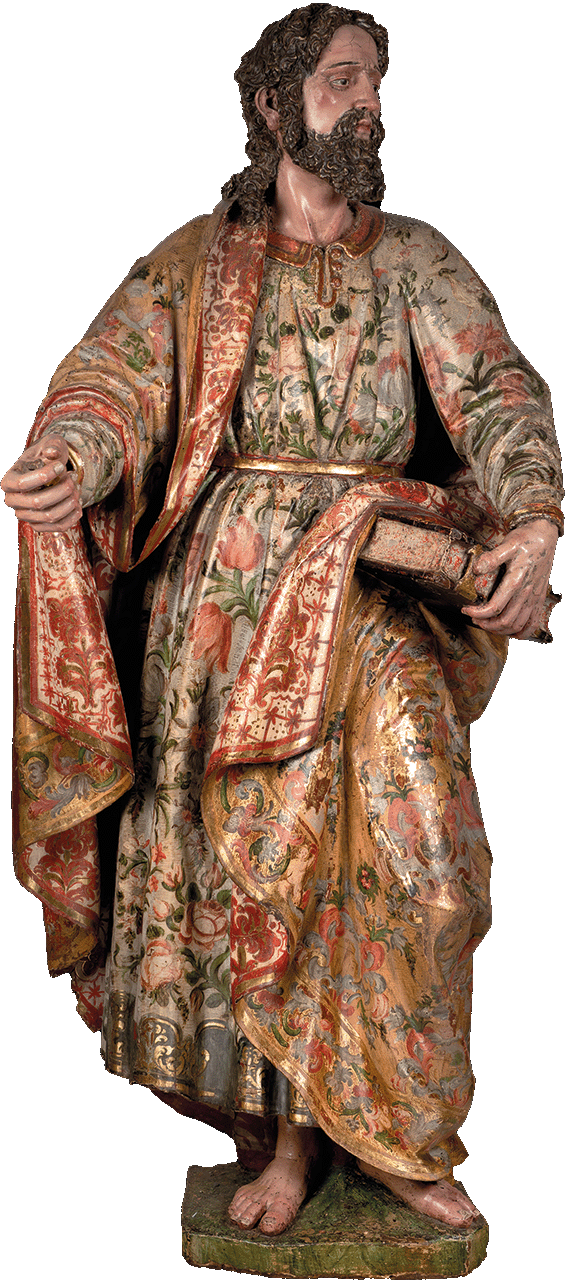

St Bartholomew
According to tradition, St Bartholomew travelled either to India or Armenia after the Crucifixion and was put to death for converting King Polimius and his family to Christianity. Although the mechanism of his fate varies significantly in early sources—with some suggesting that he was decapitated and others that he was sewn into a sack and drowned at sea—the most popular version held that he was flayed alive before rising thereafter with a pelt of human skin draped over his shoulder and continuing to preach to the masses. He is appraised accordingly not just as a symbol of macabre or inhuman suffering, but as a representation of the triumph of the spirit over the frail limitations of the flesh.
In these two seventeenth-century Granadan artworks, St Bartholomew is depicted as a knife-wielding celestial advocate. With his severed epidermis now fully restored, he becomes associated with the instrument of his torture, serving by extension as a reference to the judgement that all Christians will be required to face. In the earliest, produced by Bernabé de Gaviria, the saint is arrayed in richly decorated robes with a floral design in gold, red, green, and blue. A detailed study of this feature has yet to be undertaken, but it is likely, as is the case of other saints, that it represents an attempt to appropriate his legacy at a local cultic level. Conversely, in the latter, which remains anonymous, the contrast between red and white brings to mind the sacrificial mystery of the Eucharist along with the distinction between the whiteness of the skin and the livid redness of the flesh beneath.
A common denominator is the book in Bartholomew’s hands. Serving in part as a reference to his evangelizing ministry—providing him with the lessons that he would have offered up in extemporized oral delivery to the unenlightened—it functions simultaneously as a reminder of the transformation of skin into properties such as leather and parchment, envisioning the saint in effect as a textualization of his own identity, a writing of the divine word (the logos) in the human subject.
As a free-standing, life-size sculpture with eyes that stare directly outwards towards the observer, Gaviria’s composition plays on the relationship between appearance and reality, eliciting reactions of identification and triumph as well as fear and foreboding. A comparable element of duality is evident in the later painted version. The low line of the horizon formulates an impression of sculpted monumentality, while the pale blush of a new dawn, emerging almost imperceptibly over the mountains, hints at the triumph of goodness over evil and the never-ending certainty of celestial salvation. A feature common to Spanish artworks is the shattered tree stump, which serves inevitably as a symbol of organic regeneration and renewal.
Little is known about the origin of the sculpted version, but in view of its size, it seems most likely that it would have been displayed in a church or a religious house where the saint would have been celebrated as patron. The painted version, on the other hand, once formed part of a complete apostolate, a collection of twelve portraits, each depicting a different Apostle. Although evidence is sketchy, the most likely theory is that it was produced in the late seventeenth century and is related to a second set of Apostle paintings that are documented as having been looted by the British Navy from Puerto de Santa María, near Cádiz, in 1702.
 Click to zoom and pan
Click to zoom and pan
 Click to zoom and pan
Click to zoom and pan
...
Your feedback is very important to us. Would you like to tell us why?
We will never display your feedback on site - this information is used for research purposes.
Artwork Details
Title
St Bartholomew.
Artist
Bernabé de Gaviria (Granada, 1577–1622).
Date
1600-1622.
Medium and Support
Parcel-gilt and polychrome wood sculpture.
Dimensions
181 cm (height).
Marks and Inscriptions
None.
Acquisition Details
Unknown.
Previous Owners
Unknown.
Institution
The Spanish Gallery, Bishop Auckland.
Title
St Bartholomew.
Artist
Unknown artist (late seventeenth century).
Date
Late seventeenth century.
Medium and Support
Oil on canvas.
Dimensions
185 x 107 cm.
Marks and Inscriptions
None.
Acquisition Details
Unknown.
Previous Owners
Unknown.
Institution
University College, Durham University, 18.1214.
Bibliography
Gemma Lewis, Christopher Ferguson, and Andy Beresford, ‘Durham Castle and Cathedral: Two Sets of Spanish Apostles’, in Spanish Art in County Durham, ed. Clare Baron & Andy Beresford (Bishop Auckland: Auckland Castle Trust, The Bowes Museum, & Durham University, 2014), pp. 114–21;
Andrew M. Beresford, Sacred Skin: The Legend of St Bartholomew in Spanish Art and Literature, The Medieval and Early Modern World, 72 (Leiden: Brill, 2020);
Jonathan Ruffer, Adam Lowe, & Charlotte Skene Catling, The Spanish Gallery: A Guide to the Works of Art (Bishop Auckland: The Spanish Gallery, 2021), pp. 44–45.

